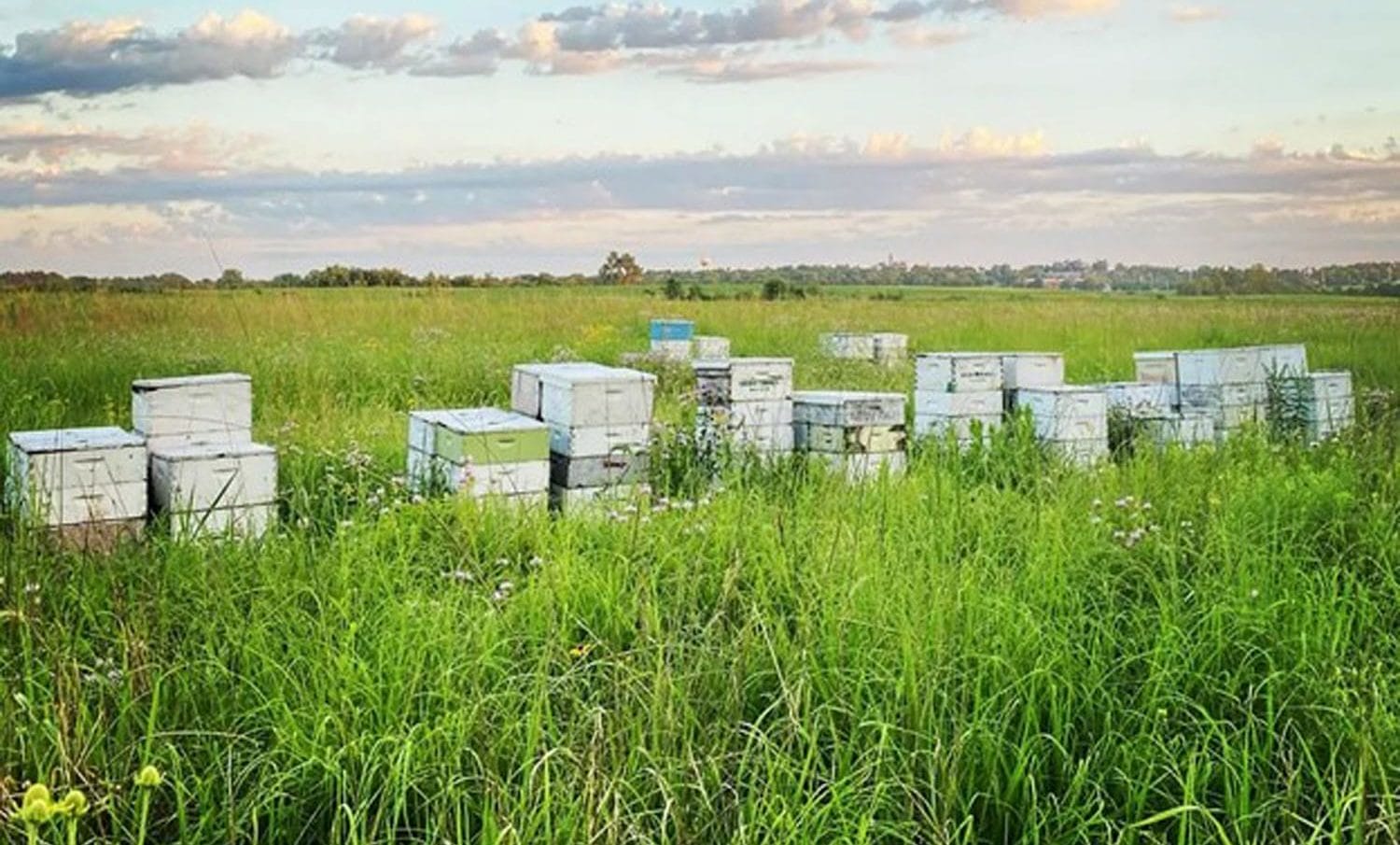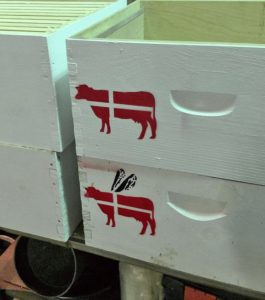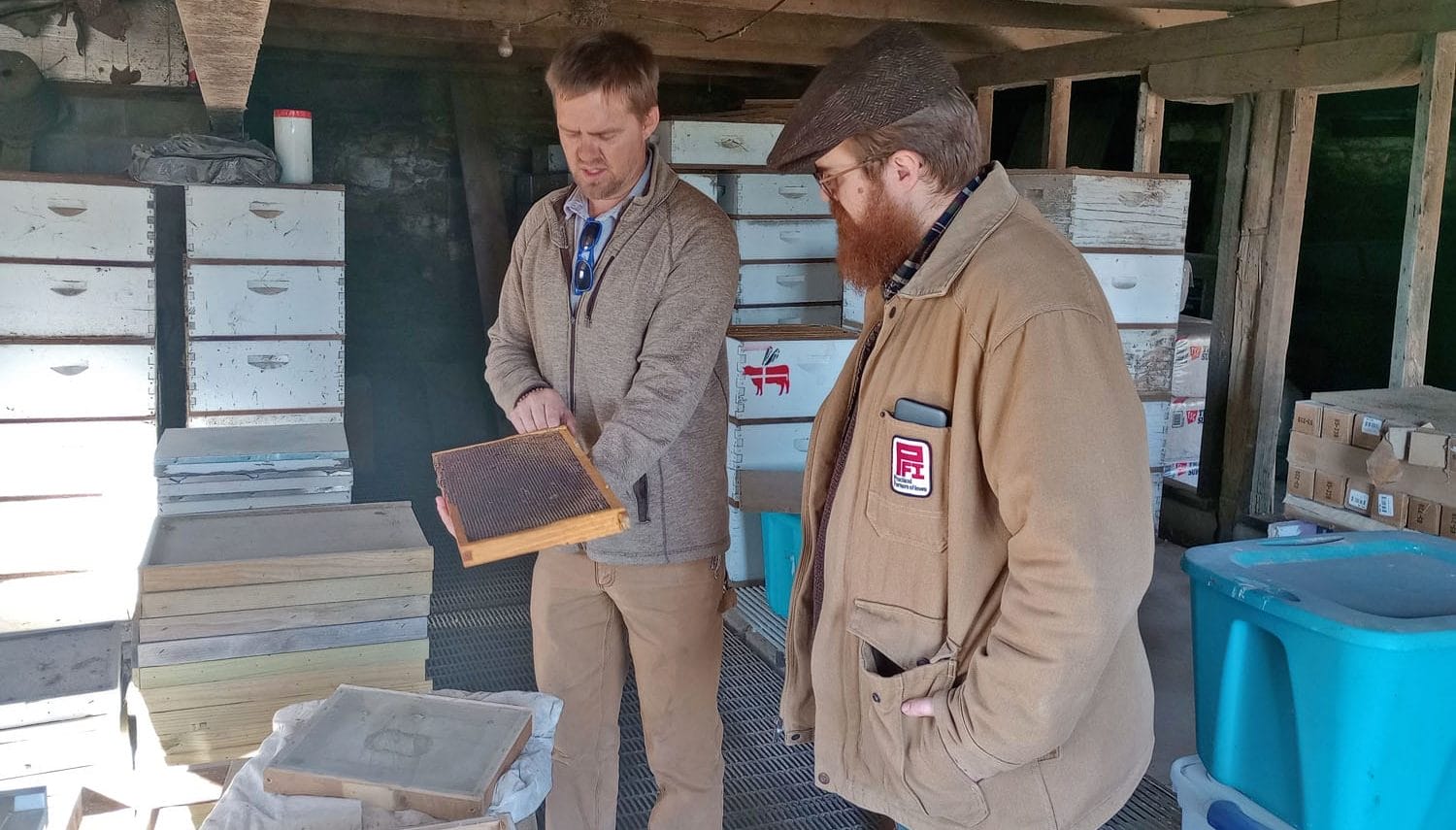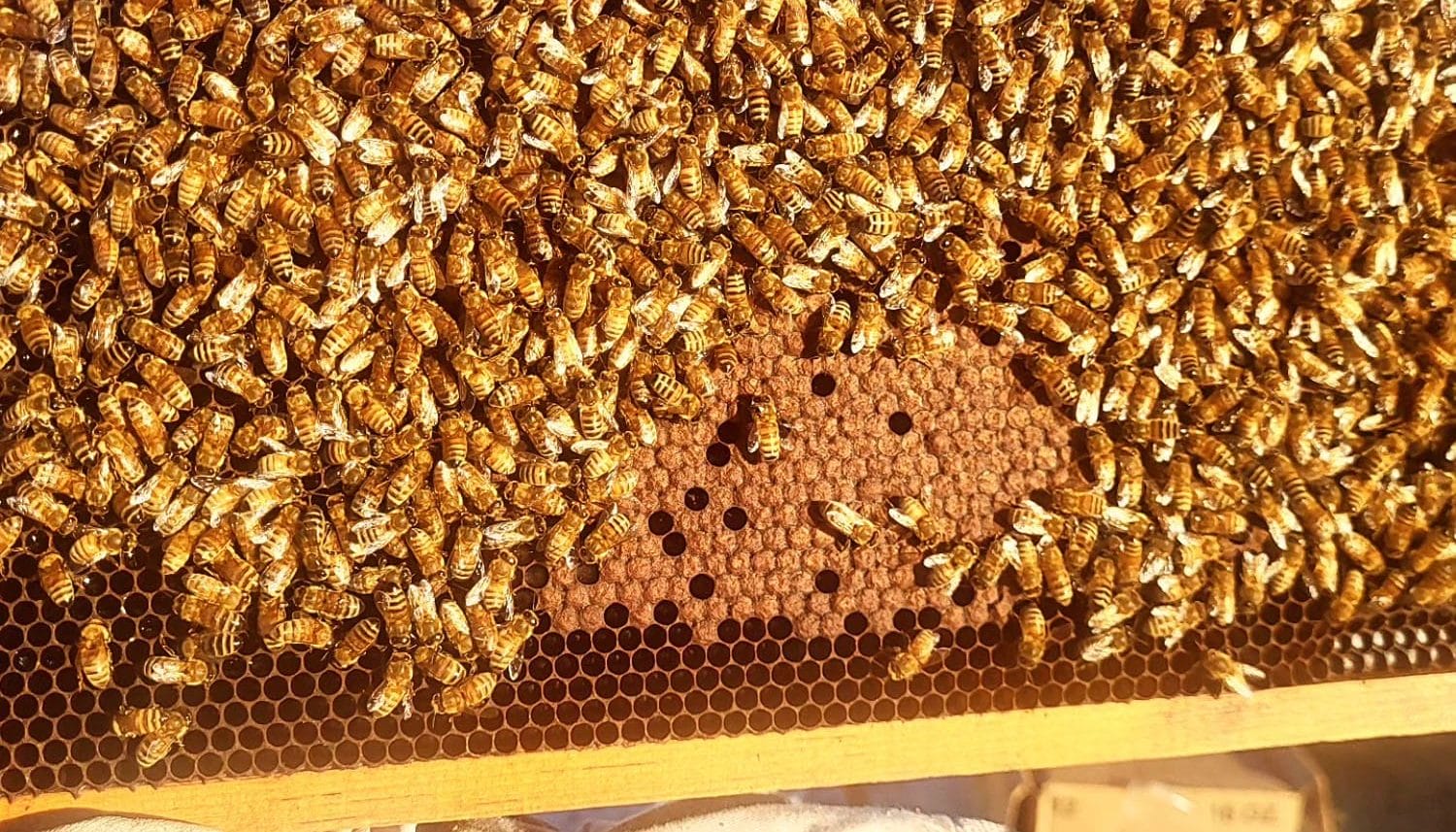Oh, for a Bee’s Experience
Even as honeybees face more serious threats to their survival in Iowa, the beekeepers who tend them find purpose and joy in bloom
The clock in the van’s dashboard said that I’m 10 minutes behind schedule. I was meant to be at the farm at 4 p.m. But as each minute passed, the digital numbers changed, reinforcing anew that I am 11 minutes late …12 minutes late.
By the time I meet Nathan Paulsen at Brun Ko Farm near Exira, Iowa, I’m a quarter of an hour late. Generously not remarking on my tardiness, he and his wife Emily take me on a tour of their beehives.
It’s late March, and compared with the crocuses that were blooming a month early and the bees already at work bringing in nectar, 15 minutes isn’t the most egregious shirking of the clock.
It can be hard to remember that time as we humans know it is a social construct. For the rest of nature, it is not measured by the rigid clock and calendar intervals that dictate our human lives.
To paraphrase Emily Dickinson, what does a bee know of noon? The bee’s world is a cycle of stimuli: The temperature warms, the temperature dips, the nectar flows, the nectar dries up. These seasonal signals have guided the ebb and flow of bees’ lives for millennia. In the last 30 to 40 years, however, life for bees – and the beekeepers who tend them – has become unpredictable and challenging.
“We didn’t realize how easy we had it before varroa mites,” says Phil Ebert, of Ebert Honey.
He’s sitting in the honey processing shed near Lynneville, Iowa, the steady whir and plop of the pump he uses to fill jars punctuating his remembering as the rich smell of honey and wax fills the air. Phil started the business in 1980 with fewer than 10 colonies. Today, he has more than 1,800 hives – and he’s experienced stark changes to bee health over the decades.
“If you had a 5% death loss over the winter, you’d gone incredibly wrong,” he says. “Now, we’re turning over at least 30% to 35% of our bees every year. It used to be how many years would a queen live. Now you just hope they make it through the season. A lot of them don’t.”
The Four Horsemen
This mysterious, often drastic, spike in bee deaths – now known as colony collapse disorder – was first identified in 2006.
Randall Cass, a bee specialist with Iowa State University Extension and Outreach, says scientists have been trying to untangle the mystery and tackle the reasons behind it for years. “The current scientific consensus,” he says, “is that rather than a single cause, it’s probably all the stressors honeybees face working together synergistically that bring down our colonies.”
These stressors can be divided into four categories: poor forage, pests, pesticides and extreme weather. “We got what I think of as the four horsemen of the apocalypse for bees,” Phil says. Mites, which arrived in the late 1980s, wouldn’t upend a colony on their own. But Nathan says they are often the nail in the coffin for many hives weakened by other factors.
“Bees typically move through a progression of jobs,” he says.
New bees start out as nurse bees who clean cells and feed eggs and larva, he explains. After that, they move to undertaker, a job that involves removing dead bees. Some advance to guard bees. The final, and most dangerous, job is that of forager. When mites start weakening the colony, the foragers are recalled to fill nurse and guard bee positions.
“Eventually,” Nathan says, “there just aren’t enough healthy forage and guard bees to take care of the hive, and it can spiral pretty fast after that.”
Many of these beleaguered hives don’t make it through the winter. According to Bee Informed Partnership, a nonprofit collaboration of university research labs across the country, Iowa consistently has among the highest winter hive loss rates.
Each year since 2007, the group has surveyed beekeepers around the country. Between April 2022 and April 2023, Iowa beekeepers reported losing nearly 40% of their bees – a drop from over 50% in the previous two years.
Randall chalks it up to Iowa having the “four horsemen” in the extremes. “I joke that we are in the ideal region of the United States to study sort of a worst-case-scenario landscape for our honeybees.”
One such extreme, Nathan and Phil agree, is the scarcity of diverse flowering plants honeybees need to sustain them. “We get calls from people who want to have bees and they’ll say, ‘I’ve got fruit trees,’” Phil says. “Well, what do you got for the other 50 weeks of the year?”
In Iowa, quality bee foraging habitat has sharply declined as more land has been converted to development and agriculture. This has made it harder for Phil to find good sites for setting up his hives. “You hope to see some wooded area or pasture, something that’s not just row crops,” says Alex Ebert, Phil’s son.
While bees will forage in corn and soybean fields, these crops have short pollination windows. Soybeans, for instance, only bloom for about two weeks in July, Randall says, leaving bees hard-pressed for food at other critical times of the year.

Native pollinator plantings help to provide critical forage for bees. Photo courtesy of the Ebert family.
The poverty of choice also undermines bee health. “Pollen is where they get their protein, and different pollens have different makeups,” Randall says. “If it’s all coming from one source, that’s not as good for them.”
Phil puts it bluntly: “These bees are malnourished.”
Strained by poor diet, hives have difficulty weathering mites and other “horsemen” of the Iowa landscape – such as weather extremes unleashed by climate change and the ubiquitous use of chemicals in row crop fields that scientists now know are harmful to bees.
Of Flowers and of Noon
Despite this cavalcade of challenges, there is joy.

The Paulsens adapted their farm logo to fit the theme on their hive boxes. Photo courtesy of the Paulsen family.
For Nathan, the practice of checking his bees is meditative. “It’s a ton of work,” he says, as he suits up and carries his equipment kit, retrofitted from his grandfather’s toolbox, out to the hives. “But Saturday mornings, going out and getting in colonies, I like it. It’s calming and soothing.”
“Beekeeping is inherently scientific,” Randall says. “Everything you do is a constant process of trial and error.”
Like farmers in PFI’s on-farm research program, beekeepers are innate enthusiasts who love to share what they’re learning. Conversations easily spiral down rabbit holes of mite control, what’s in bloom and techniques for capturing colonies. Not one to overstate, Nathan expresses his rousing endorsement of the community: “For the most part, beekeepers are generally acceptable people.”
Beekeeper organizations across the state are thriving. Both Nathan and Phil say they see more people going to classes and joining the community.
“Hobby beekeeping is one of the hottest things going on right now,” Phil says. “You see a lot of people coming into this with a high degree of enthusiasm.”
That sentiment ebbs and flows with the seasons just as honey comes in and hives die in winter. Beekeepers find solidarity with others who have gone through the same highs and lows. “It’s nice to talk about bees at our bee club,” Nathan says. “They’re good people to talk to.”
“The amount of stuff that happens in a hive is truly amazing and never fails to energize me no matter how tired I am,” Phil says.
We look on as Alex pries open the lid of the hive. As he does so, the dull drone of thousands of bees inside becomes an acute chorus of strings tuning for a winged song whose loud humming modulates rapidly in pitch.
The buzz nestles into the brain, activating a primal instinct. While not overtly threatening, being so close to the thrum makes my hairs stand on end, and my ears perk up.
An unconcerned Phil scratches his back on a truck like a bear waiting for honey, while Alex moves with a practiced tranquility that calms both the hive – and my nerves. I watch as Alex’s farm-worn hands slowly lift a frame from the box. With delicate precision that bespeaks his years of experience, he avoids crushing the fragile bees.
Maneuvering the frame into the sunlight, the comb glows gold and heavy with bees as Alex explains the organized chaos of activity.
Finally, a bee dangles from his pinky, its stinger embedded in the sensitive pad. “I think it’s time we let them be,” Alex says quietly as he lowers the frame back into the hive and closes the lid. Instead of anger at being stung, he simply accepts it as the price of honey, and pities that the bee had the worse day.
He is attuned to the moment – to what the bees are signaling – just as bees live in moments. For bees, those moments are full of flowers, pieced together one after the other.
I think it must be nice to live without a clock ticking down the precious moments of life.
If we worry always about being late, we might miss the beauty of those early crocus blooms.
Amid the work, and challenges, of caring for hives, processing honey and contemplating the future of Iowa’s landscape, beekeepers live in tune with their six-legged flocks. It’s not a vocation for the faint of heart. But for those drawn to its wonders and its woes, echoes of this line from Emily Dickinson abound: “Oh for a bee’s experience of clovers and of noon!”





